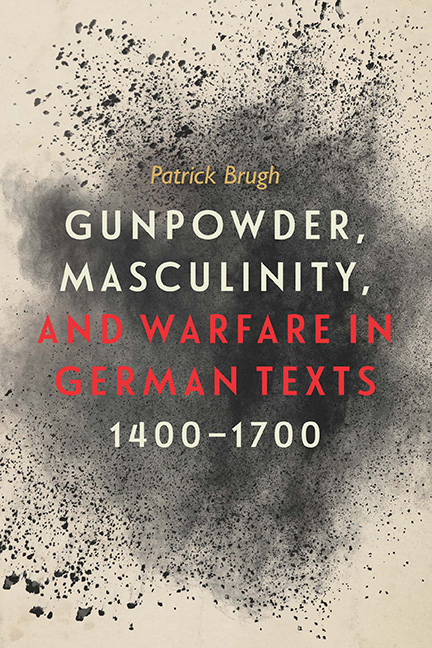Book contents
- Frontmatter
- Dedication
- Contents
- List of Illustrations
- Acknowledgments
- A Note on Translation and Spelling
- Abbreviations
- 1 A Tale of Two Suits of Armor
- 2 Of Hussites and Haystacks, of Questions and Cannons
- 3 Textbook War: The Genealogy of Kriegsbücher
- 4 Gunpowder Dilemmas and Loaded Peace in Fronsperger's Kriegsbuch
- 5 Depicting Gunpowder in German Military Broadsheets (1630–32)
- 6 Gustav Adolf's Gunpowder Demise
- 7 The Aesthetics of Gunpowder in Seventeenth-Century German War Novels
- 8 Cavalier Endings in Happel's Der insulanische Mandorell (1682)
- Appendix: Comparisons of Broadsheets from Battles of Breitenfeld, Rain am Lech, and Lützen
- Notes
- Bibliography
- Index
8 - Cavalier Endings in Happel's Der insulanische Mandorell (1682)
Published online by Cambridge University Press: 25 March 2020
- Frontmatter
- Dedication
- Contents
- List of Illustrations
- Acknowledgments
- A Note on Translation and Spelling
- Abbreviations
- 1 A Tale of Two Suits of Armor
- 2 Of Hussites and Haystacks, of Questions and Cannons
- 3 Textbook War: The Genealogy of Kriegsbücher
- 4 Gunpowder Dilemmas and Loaded Peace in Fronsperger's Kriegsbuch
- 5 Depicting Gunpowder in German Military Broadsheets (1630–32)
- 6 Gustav Adolf's Gunpowder Demise
- 7 The Aesthetics of Gunpowder in Seventeenth-Century German War Novels
- 8 Cavalier Endings in Happel's Der insulanische Mandorell (1682)
- Appendix: Comparisons of Broadsheets from Battles of Breitenfeld, Rain am Lech, and Lützen
- Notes
- Bibliography
- Index
Summary
Both cavalier and steed fell to the ground,
But, while in one all signs of life had ceased,
The other leapt up nimbly with one bound,
As though his strength and vigour were increased.
—Ludovico Ariosto, Orlando FuriosoThe disappearance of the knight from the battlefield, or, better put, the transformation of knights into an aristocratic and upper-bourgeois officer class in the sixteenth and seventeenth centuries was, to some extent, the result of the widespread use of gunpowder weapons on the battlefield. Regardless of how military historians frame the alterations to warfare that coincide with the rise of gunpowder technology, the cultural implications of gunpowder weapons in the fifteenth through seventeenth centuries hint at a synthetic rather than decisive answer to the question of gunpowder's influence on warfare. As a technology of war represented textually, guns were perceived well into the seventeenth century as both a startling disruption and a pragmatic addition to the cultural traditions of warfare. In the works of military theorists, proto-journalists, literary authors, graphic artists, and humanists, depictions of gunpowder technology in early modern German lands reveal a continuum of reactions to gunpowder weapons that range from cautiously accepting to vehemently critical.
This continuum indicates that gunpowder weapons occupied a contingent position in the German cultural landscape, despite their long history as tools of war and as objects widely possessed and used by civilians, especially townspeople in compulsory city militias, since the sixteenth century. Seen as problematic by those who compared their experiences of war to the idealized depictions of ancient and medieval warriors, gunpowder weapons could be disparaged as evidence of the moral, gendered, and even aesthetic degeneration of war and warriors. Other representations of gunpowder, such as those found in military broadsheets and seventeenthcentury Kriegsb ücher, depicted them as either positive or negative depending on who used them. Representations of gunpowder weapons in early modern German poetry, not considered in depth in this study, confirm their symbolic malleability. Pro-war poetry, such as Paul Fleming's (1609– 40) “Lob eines Soldaten zu Fuße” (Praise of a Foot Soldier), presents gunpowder positively:
… Wer Pulver riechen kann, auf Balg und Stoß besteht, nicht die Kartaunen scheuet, der ist ein Mann wie ich; ist einer der sich freuet, wenn itzt der laute Larm mit vollen Spielen geht und uns der kuhne Feind im blanken Felde steht.
- Type
- Chapter
- Information
- Gunpowder, Masculinity, and Warfare in German Texts, 1400–1700 , pp. 184 - 198Publisher: Boydell & BrewerPrint publication year: 2019

